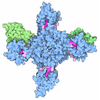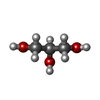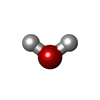+ Open data
Open data
- Basic information
Basic information
| Entry | Database: PDB / ID: 8zhs | ||||||
|---|---|---|---|---|---|---|---|
| Title | Structure of Mbp-Bte1 fusion protein | ||||||
 Components Components |
| ||||||
 Keywords Keywords | ANTITOXIN / antibacterial toxin | ||||||
| Function / homology |  Function and homology information Function and homology informationdetection of maltose stimulus / maltose transport complex / carbohydrate transport / carbohydrate transmembrane transporter activity / maltose binding / maltose transport / maltodextrin transmembrane transport / ATP-binding cassette (ABC) transporter complex, substrate-binding subunit-containing / ATP-binding cassette (ABC) transporter complex / cell chemotaxis ...detection of maltose stimulus / maltose transport complex / carbohydrate transport / carbohydrate transmembrane transporter activity / maltose binding / maltose transport / maltodextrin transmembrane transport / ATP-binding cassette (ABC) transporter complex, substrate-binding subunit-containing / ATP-binding cassette (ABC) transporter complex / cell chemotaxis / outer membrane-bounded periplasmic space / periplasmic space / DNA damage response / membrane Similarity search - Function | ||||||
| Biological species |   Bacteroides fragilis NCTC 9343 (bacteria) Bacteroides fragilis NCTC 9343 (bacteria) | ||||||
| Method |  X-RAY DIFFRACTION / X-RAY DIFFRACTION /  SYNCHROTRON / SYNCHROTRON /  MOLECULAR REPLACEMENT / Resolution: 2.4 Å MOLECULAR REPLACEMENT / Resolution: 2.4 Å | ||||||
 Authors Authors | Xu, J.H. / Chen, Z. / Gao, X. | ||||||
| Funding support | 1items
| ||||||
 Citation Citation |  Journal: Cell Host Microbe / Year: 2025 Journal: Cell Host Microbe / Year: 2025Title: A human gut bacterium antagonizes neighboring bacteria by altering their protein-folding ability. Authors: Bentley Lim / Jinghua Xu / Igor H Wierzbicki / Carlos G Gonzalez / Zhe Chen / David J Gonzalez / Xiang Gao / Andrew L Goodman /   Abstract: Antagonistic interactions play a key role in determining microbial community dynamics. Here, we report that one of the most widespread contact-dependent effectors in human gut microbiomes, Bte1, ...Antagonistic interactions play a key role in determining microbial community dynamics. Here, we report that one of the most widespread contact-dependent effectors in human gut microbiomes, Bte1, directly targets the PpiD-YfgM periplasmic chaperone complex in related microbes. Structural, biochemical, and genetic characterization of this interaction reveals that Bte1 reverses the activity of the chaperone complex, promoting substrate aggregation and toxicity. Using Bacteroides, we show that Bte1 is active in the mammalian gut, conferring a fitness advantage to expressing strains. Recipient cells targeted by Bte1 exhibit sensitivity to membrane-compromising conditions, and human gut microbes can use this effector to exploit pathogen-induced inflammation in the gut. Further, Bte1 allelic variation in gut metagenomes provides evidence for an arms race between Bte1-encoding and immunity-encoding strains in humans. Together, these studies demonstrate that human gut microbes alter the protein-folding capacity of neighboring cells and suggest strategies for manipulating community dynamics. | ||||||
| History |
|
- Structure visualization
Structure visualization
| Structure viewer | Molecule:  Molmil Molmil Jmol/JSmol Jmol/JSmol |
|---|
- Downloads & links
Downloads & links
- Download
Download
| PDBx/mmCIF format |  8zhs.cif.gz 8zhs.cif.gz | 261.2 KB | Display |  PDBx/mmCIF format PDBx/mmCIF format |
|---|---|---|---|---|
| PDB format |  pdb8zhs.ent.gz pdb8zhs.ent.gz | 203.2 KB | Display |  PDB format PDB format |
| PDBx/mmJSON format |  8zhs.json.gz 8zhs.json.gz | Tree view |  PDBx/mmJSON format PDBx/mmJSON format | |
| Others |  Other downloads Other downloads |
-Validation report
| Summary document |  8zhs_validation.pdf.gz 8zhs_validation.pdf.gz | 474.1 KB | Display |  wwPDB validaton report wwPDB validaton report |
|---|---|---|---|---|
| Full document |  8zhs_full_validation.pdf.gz 8zhs_full_validation.pdf.gz | 488.3 KB | Display | |
| Data in XML |  8zhs_validation.xml.gz 8zhs_validation.xml.gz | 54.5 KB | Display | |
| Data in CIF |  8zhs_validation.cif.gz 8zhs_validation.cif.gz | 72 KB | Display | |
| Arichive directory |  https://data.pdbj.org/pub/pdb/validation_reports/zh/8zhs https://data.pdbj.org/pub/pdb/validation_reports/zh/8zhs ftp://data.pdbj.org/pub/pdb/validation_reports/zh/8zhs ftp://data.pdbj.org/pub/pdb/validation_reports/zh/8zhs | HTTPS FTP |
-Related structure data
| Related structure data |  8zhtC C: citing same article ( |
|---|---|
| Similar structure data | Similarity search - Function & homology  F&H Search F&H Search |
- Links
Links
- Assembly
Assembly
| Deposited unit | 
| ||||||||||||
|---|---|---|---|---|---|---|---|---|---|---|---|---|---|
| 1 |
| ||||||||||||
| Unit cell |
|
- Components
Components
| #1: Protein | Mass: 55985.680 Da / Num. of mol.: 2 / Mutation: D108A/K109A/E198A/N199A/K265A Source method: isolated from a genetically manipulated source Details: Sequence reference of MBP for strain 'Acinetobacter baumannii' is not available in UniProt at the time of biocuration. Current sequence reference is from UniProt id P0AEX9. Source: (gene. exp.)   Bacteroides fragilis NCTC 9343 (bacteria) Bacteroides fragilis NCTC 9343 (bacteria)Gene: malE, b4034, JW3994, BF9343_1937 / Production host:  #2: Protein | Mass: 12963.899 Da / Num. of mol.: 2 Source method: isolated from a genetically manipulated source Source: (gene. exp.)  Bacteroides fragilis NCTC 9343 (bacteria) Bacteroides fragilis NCTC 9343 (bacteria)Gene: BF9343_1937 / Production host:  #3: Chemical | ChemComp-GOL / #4: Water | ChemComp-HOH / | Has ligand of interest | N | Has protein modification | Y | |
|---|
-Experimental details
-Experiment
| Experiment | Method:  X-RAY DIFFRACTION / Number of used crystals: 1 X-RAY DIFFRACTION / Number of used crystals: 1 |
|---|
- Sample preparation
Sample preparation
| Crystal | Density Matthews: 2.75 Å3/Da / Density % sol: 55.19 % |
|---|---|
| Crystal grow | Temperature: 291.15 K / Method: vapor diffusion, hanging drop Details: 10% v/v 2-Propanol, 0.1 M BICINE pH 8.5 and 30% w/v PEG1500 |
-Data collection
| Diffraction | Mean temperature: 100 K / Serial crystal experiment: N |
|---|---|
| Diffraction source | Source:  SYNCHROTRON / Site: NFPSS SYNCHROTRON / Site: NFPSS  / Beamline: BL18U / Wavelength: 0.987 Å / Beamline: BL18U / Wavelength: 0.987 Å |
| Detector | Type: DECTRIS PILATUS3 6M / Detector: PIXEL / Date: Aug 24, 2022 |
| Radiation | Protocol: SINGLE WAVELENGTH / Monochromatic (M) / Laue (L): M / Scattering type: x-ray |
| Radiation wavelength | Wavelength: 0.987 Å / Relative weight: 1 |
| Reflection | Resolution: 2.4→42.13 Å / Num. obs: 55319 / % possible obs: 93.21 % / Redundancy: 10.3 % / Biso Wilson estimate: 40.3 Å2 / CC1/2: 0.99 / Net I/σ(I): 1.56 |
| Reflection shell | Resolution: 2.4→2.5 Å / Num. unique obs: 4190 / CC1/2: 0.53 |
- Processing
Processing
| Software |
| |||||||||||||||||||||||||||||||||||||||||||||||||||||||||||||||||||||||||||||||||||||||||||||||||||||||||
|---|---|---|---|---|---|---|---|---|---|---|---|---|---|---|---|---|---|---|---|---|---|---|---|---|---|---|---|---|---|---|---|---|---|---|---|---|---|---|---|---|---|---|---|---|---|---|---|---|---|---|---|---|---|---|---|---|---|---|---|---|---|---|---|---|---|---|---|---|---|---|---|---|---|---|---|---|---|---|---|---|---|---|---|---|---|---|---|---|---|---|---|---|---|---|---|---|---|---|---|---|---|---|---|---|---|---|
| Refinement | Method to determine structure:  MOLECULAR REPLACEMENT / Resolution: 2.4→42.13 Å / SU ML: 0.2881 / Cross valid method: FREE R-VALUE / σ(F): 1.36 / Phase error: 26.5905 MOLECULAR REPLACEMENT / Resolution: 2.4→42.13 Å / SU ML: 0.2881 / Cross valid method: FREE R-VALUE / σ(F): 1.36 / Phase error: 26.5905 Stereochemistry target values: GeoStd + Monomer Library + CDL v1.2
| |||||||||||||||||||||||||||||||||||||||||||||||||||||||||||||||||||||||||||||||||||||||||||||||||||||||||
| Solvent computation | Shrinkage radii: 0.9 Å / VDW probe radii: 1.1 Å / Solvent model: FLAT BULK SOLVENT MODEL | |||||||||||||||||||||||||||||||||||||||||||||||||||||||||||||||||||||||||||||||||||||||||||||||||||||||||
| Displacement parameters | Biso mean: 47.72 Å2 | |||||||||||||||||||||||||||||||||||||||||||||||||||||||||||||||||||||||||||||||||||||||||||||||||||||||||
| Refinement step | Cycle: LAST / Resolution: 2.4→42.13 Å
| |||||||||||||||||||||||||||||||||||||||||||||||||||||||||||||||||||||||||||||||||||||||||||||||||||||||||
| Refine LS restraints |
| |||||||||||||||||||||||||||||||||||||||||||||||||||||||||||||||||||||||||||||||||||||||||||||||||||||||||
| LS refinement shell |
|
 Movie
Movie Controller
Controller




 PDBj
PDBj





